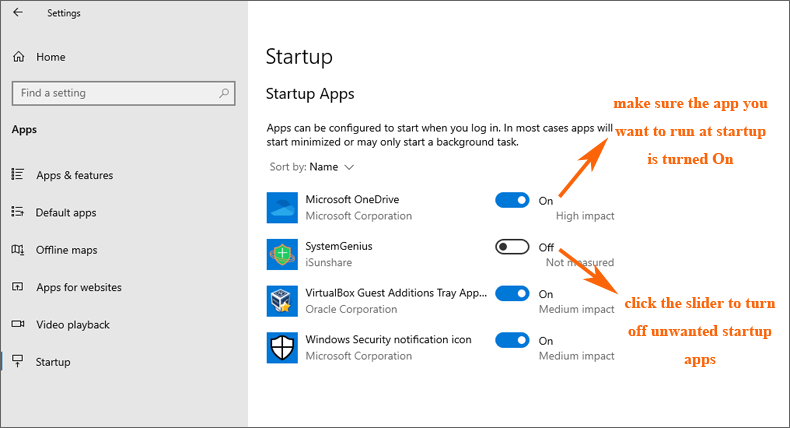

- #WINDOWS MAKE A PROGRAM RUN AT STARTUP HOW TO#
- #WINDOWS MAKE A PROGRAM RUN AT STARTUP INSTALL#
- #WINDOWS MAKE A PROGRAM RUN AT STARTUP WINDOWS 10#
- #WINDOWS MAKE A PROGRAM RUN AT STARTUP SOFTWARE#
- #WINDOWS MAKE A PROGRAM RUN AT STARTUP PC#
In order to start auto start a program, you should know some details of the programs you wish to start.įor example, if you wish to always start Microsoft Edge browser after you login, you’ll need find out what commands and switches or options are used to start Edge up. Windows has a Startup folder that automatically start any program that is added to the folder. After the windows boots up it runs (equivalent to double-clicking) all the application present in its startup directory. Step 1: Adding script to windows Startup folder. I have the same question (70) Report abuse Report abuse. You can follow the question or vote as helpful, but you cannot reply to this thread.
#WINDOWS MAKE A PROGRAM RUN AT STARTUP WINDOWS 10#
To get started with starting programs when you login, follow the steps below: Find Program Details Adding a Python script to windows start-up basically means the python script will run as the windows boots up. How set a program to run at start up in Windows 10 In windows 10 how can I set programs to start automatically at Startup In XP there was the start up folder but I cant find any equivalent in Win 10. Windows 11 is the successor to Windows 10 and it’s expected to be released later this year. Windows 11 is a major release of the Windows NT operating system developed by Microsoft.
#WINDOWS MAKE A PROGRAM RUN AT STARTUP HOW TO#
Programs that are not designed or built to automatically start up or open, you will have to manually configure and set them to start.Īlso, when you’re a student and new user and you want to learn how to use Windows, the easiest place to start is Windows 11.

Make an app load at Windows 10 startup, using the Task Manager 4. Use the Windows 10 Settings to enable an app to run at startup 3. They will automatically start up everytime Windows starts. Check the settings of the app that you want to run at Windows 10 startup 2. On most Windows computers, you can access the Task. For programs that are designed to startup automatically, there’s nothing to do. In Windows 8 and 10, the Task Manager has a Startup tab to manage which applications run on startup.

#WINDOWS MAKE A PROGRAM RUN AT STARTUP INSTALL#
If you bump into any problems with a program you’ve disabled, return to the Settings screen or to Task Manager and welcome it back into your startup routine.Windows allows programs to automatically install themselves in Windows startup configuration settings. You can then register the service and set it to start when the system starts. That should handle all the background stuff. Click 'More Details' at the bottom of the Manager, and then select the Start-up tab at the top. Your safest bet is to disable one app at a time, restart your PC, and then make sure you and Windows can live without the program running at startup. To allow it to run without a user session, you need a windows service. Open the Task Manager by right-clicking the Windows icon, or by pressing Ctrl-Alt-Delete. Anything disabled will be labeled as such in the Status column. Note: This is the usual method to run any program at Windows startup (by using registry), but applies only to programs that does not need administrative. To kick an app out of the startup sequence, right-click on it and select Disable.
#WINDOWS MAKE A PROGRAM RUN AT STARTUP SOFTWARE#
The challenge here is to hunt down the ones that don't need to launch at startup while not disturbing the ones that do.īy default, the list should be sorted by name, but you can click any of the headings to sort the list by software publisher, startup status, and startup impact. Some of the programs you’ll likely recognize others may be unfamiliar. You’ll see a list of all the apps that start up automatically each time Windows loads. In the Task Manager window, click the tab for Startup (you may need to click More details first). Go to Settings > Apps > Startup to view a list of all apps that can start up automatically and determine which should be disabled. Another way to Add an App or Program to Startup in Windows is to open the Startup Folder on your computer and drag the App or Program Icon to this Folder. Set it to Specific user: and then choose your user (Administrator). In Windows 11, click the Search icon, type Task Manager, then select Task Manager from the results. Triggers Tab: Click New and then select Begin the task: At log on. From the pop-up menu, click the command for Task Manager. In Windows 10, right-click on any empty area of the Taskbar in Windows 10. Reviewing your startup apps through Task Manager allows you to more easily research each one to better gauge whether or not to disable it.
#WINDOWS MAKE A PROGRAM RUN AT STARTUP PC#


 0 kommentar(er)
0 kommentar(er)
